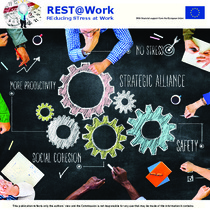REST@work: REducing STress at Work. Work-related stress: a risk to be managed together
"Psychosocial risks and work-related stress are one of the most important problems of the current labour world, capable of causing severe consequences both on workers’ health and on the companies’ production capacity. With a view to tackling this problem, in recent years many initiatives have b...
| Main Authors: | , , |
|---|---|
| Institution: | ETUI-European Trade Union Institute |
| Format: | TEXT |
| Language: | English |
| Published: |
Roma
2017
UIL |
| Subjects: | |
| Online Access: | https://www.labourline.org/KENTIKA-19397556124911157389-ReST@work-Reducing-STress-at-W.htm |
| Summary: | "Psychosocial risks and work-related stress are one of the most important problems of the current labour world, capable of causing severe consequences both on workers’ health and on the companies’ production capacity. With a view to tackling this problem, in recent years many initiatives have been undertaken in the European countries designed to provide to the labour world useful strategies, methodologies and tools to combat this phenomenon and promote organizational well-being at the workplace.
With regard to work-related stress, the main cornerstone is undoubtedly the European Agreement of October 8, 2004. In a scenario previously characterized by ambiguity and uncertainty also at scientific level, the agreement represented a clear and definitive paradigm shift. By showing that not all situations requiring intense work cause stress and that not all stressful situations are work-related, the Agreement has defined the boundaries within which work-related stress is to be placed and has outlined the pathway for prevention actions. Several tools have been developed to support companies in the process of evaluating and finding effective protection measures. Both subjective tools, such as questionnaires, designed to study workers’ perception, and objective observational tools, designed to analyse the organization of work and measure work-related stress phenomena such as absenteeism and turn- over, have been proposed. All these tools, however, are easier to apply in larger companies. ..." |
|---|---|
| Physical Description: | 62 p. Digital Paper |

